Related Research Articles

Salvador Guerrero Quesada, better known as Gory Guerrero, was one of the premier Mexican-American professional wrestlers in the early days of Lucha Libre when most wrestlers were imported from outside Mexico. He wrestled primarily in Empresa Mexicana de la Lucha Libre (EMLL) between the 1940s and 1960s. He was also the patriarch of the Guerrero wrestling family.
Roberto Gutiérrez Frías is a Mexican retired professional wrestler and wrestling trainer, best known under the ring name El Dandy. He is the cousin of professional wrestler Juan Conrado Aguilar, known as El Texano, and the uncle of Aguilar's sons, who wrestle as El Texano Jr. and Súper Nova. While he had a retirement tour in 2014, Gutiérrez has wrestled most recently in March 2019. Gutiérrez has wrestled for most major Mexican promotions, including Consejo Mundial de Lucha Libre, Lucha Libre AAA Worldwide, Universal Wrestling Association, World Wrestling Association, and International Wrestling Revolution Group. In addition, he has worked for the US-based World Championship Wrestling as well as the Japanese Super World Sports and the International Wrestling Association of Japan.
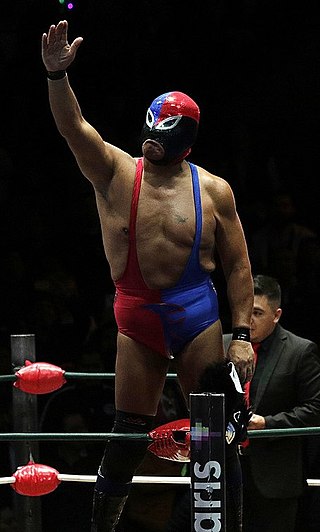
Fuerza Guerrera is a Mexican Luchador enmascarado who made his debut in 1978. In his career Guerrera has worked for every major wrestling organization in Mexico including Consejo Mundial de Lucha Libre (CMLL), AAA, Universal Wrestling Association (UWA), World Wrestling Association (WWA) and International Wrestling Revolution Group (IWRG). Throughout his career Fuerza Guerrera has held many titles for CMLL, AAA and IWRG. Fuerza Guerrera's real name is not a matter of public record, as is often the case with masked wrestlers in Mexico where their private lives are kept a secret from the wrestling fans. Only his paternal surname is known, as his son Eduardo Aníbal González Hernández' name is a matter of public record making Fuerza Guerrera's paternal surname "González" as well. Eduardo González is better known as luchador Juventud Guerrera. Fuerza Guerrera is Spanish for "Warrior Strength", not to be mistaken for the surname Guerrero.
The NWA World Middleweight Championship was a professional wrestling championship in the National Wrestling Alliance (NWA) between 1939 and 2010. For most of its existence, it was defended in the Mexican lucha libre promotion Consejo Mundial de Lucha Libre (CMLL), who called it the Campeonato Mundial Peso Medio de NWA. As it is a professional wrestling championship, its holders were determined by promoters or promotions, not by athletic competition. The official middleweight limits in lucha libre are 82 kg (181 lb) to 87 kg (192 lb), but this rule is broken when convenient.
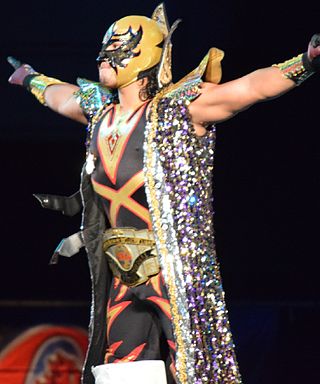
The CMLL World Welterweight Championship is a professional wrestling world championship in the Mexican professional wrestling promotion Consejo Mundial de Lucha Libre (CMLL). The official definition of the welterweight division in Mexico is between 70 kg (150 lb) and 78 kg (172 lb) but the official weight limits are not always adhered to. As with other professional wrestling championships, it is not won or lost competitively but is instead scripted by the bookers of a wrestling promotion. The title is awarded after the chosen wrestler "wins" a match.
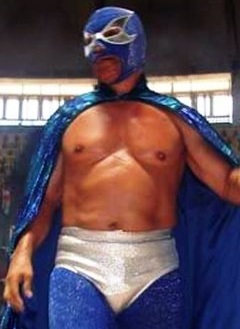
Juan Baños was a Mexican luchador enmascarado, or masked professional wrestler better known by the ring name Lizmark. The name was taken from the German battleship Bismarck. He was a multiple-time champion, having held singles and tag team championships in both Empresa Mexicana de Lucha Libre / Consejo Mundial de Lucha Libre (EMLL/CMLL) and Asistencia Asesoría y Administración (AAA). In 2001, Lizmark was inducted into the Wrestling Observer Newsletter Hall of Fame. His nickname was El Geniecillo Azul, which is Spanish for "The Little Blue Genius". He has two sons who are also professional wrestlers, Lizmark, Jr. and El Hijo de Lizmark.
Celso Reyes Daza is a luchador, or professional wrestler, best known under his ring name Ciclón Ramírez. Reyes worked as Pegaso I for six years before switching to the Ciclón Ramirez name in 1988. As Ramirez he originally worked as an enmascarado, or masked wrestler but was unmasked after losing a Luchas de Apuestas, or bet fight, to El Felino. The character "Ciclón Ramirez" is billed as a relative of the character Huracán Ramírez, which is a storyline invented for wrestling. Reyes' son currently works as Ciclón Ramírez Jr.
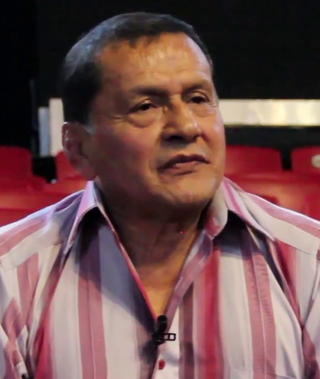
Arturo Beristain is a Mexican retired professional wrestler, or Luchador in Spanish, who works as a wrestling trainer at the Mexican professional wrestling promotion Consejo Mundial de Lucha Libre's (CMLL) gym in Mexico City, Mexico. Beristain is best known for working under two different ring names, Talismán and El Hijo del Gladiador; both personas started out as enmascarados, or masked, and Beristain lost both masks in Luchas de Apuestas. He lost the Talismán mask to Atlantis in 1984 and the Hijo del Gladiador mask to Rencor Latino in 2000. As Talismán, Beristain won the Mexican National Welterweight Championship twice, the Mexican National Middleweight Championship and the Mexican National Lightweight Championship. As el Hijo del Gladiador he has won the CMLL World Trios Championship with Gran Markus, Jr. and Dr. Wagner Jr. and the IWRG Intercontinental Middleweight Championship. When Beristain lost the "Hijo del Gladiador" he was announced as "Arturo Beristain Ramírez" to further the storyline that he was actually the son of wrestler "El Gladiador", but his last name is not actually Ramírez.
José Luis Barajas Fernández is a retired Mexican professional wrestler, or Luchador as they are called in Spanish. Barajas is best known under the ring name, El Faraón, a ring name and persona he used throughout his career from his debut in 1973 until retiring around the turn of the millennium. El Fareón was originally an enmascarado but lost a Luchas de Apuestas, or "bet match" to Fishman on April 23, 1973 and was forced to unmask. Barajas' career peak came in the 1980s where he won the NWA World Middleweight Championship, NWA World Light Heavyweight Championship and the Mexican National Middleweight Championship, in addition to a long-running, intense storyline feud against Sangre Chicana that saw the two face off in a series of very bloody matches.
Javier Hernández Padilla is a semi-retired Mexican Luchador, or professional wrestler best known under the ring name Américo Rocca. Hernández also worked as the enmascarado (masked) Ponzoña from 1990 until 1994, and as Ninja Samurai for a brief time in 1994. Hernández is a former holder of the Mexican National Lightweight Championship and a three-time holder of both the Mexican National Welterweight Championship and the NWA World Welterweight Championship all promoted by the professional wrestling promotion Empresa Mexicana de Lucha Libre (EMLL).
Ismael Muñoz Lopez was a Mexican Luchador or professional wrestler best known under the ring name Alberto Muñoz. Muñoz was active from 1964 until the 1980s. Muñoz worked for most of his career using his real name, but in the 1970s he also wrestled as the enmascaradoWhite Man, teaming with Black Man to form a popular tag team. In his career Muñoz held several top championships promoted by Empresa Mexicana de Lucha Libre (EMLL).

Marcelo Andreani was a Mexican professional wrestler best known under the ring name "Roughouse" Jack O'Brien and worked mainly in Mexico for Empresa Mexicana de Lucha Libre (EMLL) where he held the Mexican National Lightweight Championship, Mexican National Welterweight Championship and NWA World Welterweight Championship twice during his career that spanned from 1934 until 1956. O'Brien is credited with inventing the Abdominal Stretch, or Tirabuzón.
Manuel Cota Soto was a Mexican luchador, or professional wrestler best known under the ring name Mocho Cota. "Mocho" is Spanish for "mutilated", and Cota had lost two fingers. In his career, which began in 1979, he held both the Mexican National Welterweight Championship and the NWA World Welterweight Championship. He worked mainly for Empresa Mexicana de Lucha Libre / Consejo Mundial de Lucha Libre throughout his career.

Jesús Reza Rosales is a Mexican Luchador, or professional wrestler, best known under the ring name Mano Negra. Mano Negra is Spanish for "The Black Hand" and is taken from the Spanish anarchist organisation La Mano Negra. Rosales is a former two time holder of the NWA World Welterweight Championship, two time holder of the NWA World Light Heavyweight Championship, and the Mexican National Light Heavyweight Championship while working for Empresa Mexicana de Lucha Libre (EMLL). He also worked for the Universal Wrestling Association (UWA) where he held the UWA World Junior Light Heavyweight Championship and for the World Wrestling Association (WWA) where he held the WWA Lightweight Championship. Mano Negra was originally an Enmascarado, or masked wrestler, but lost a Lucha de Apuesta, bet match, to Atlantis in the main event of CMLL's 60th Anniversary Show and was forced to unmask.

Arturo Casco Hernández was a Mexican luchador, or professional wrestler, best known under the ring name La Fiera, which is Spanish for "The Wild Beast". Hernández was a second-generation wrestler, following in the footsteps of his father Hércules Poblano. His brother wrestled as Ángel Poblano.
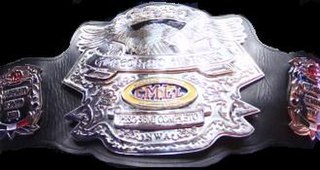
The NWA World Historic Middleweight Championship is a professional wrestling championship promoted by Consejo Mundial de Lucha Libre (CMLL). The official definition of the middleweight weight class in Mexico is between 82 kg (181 lb) and 87 kg (192 lb), but is not always strictly enforced. For example, previous NWA World Historic Middleweight Champion Último Guerrero is billed as weighing 95 kg (209 lb). Místico is the current champion, he is the eighth champion overall and he is in his first reign.

The NWA World Historic Light Heavyweight Championship is a professional wrestling championship promoted by Consejo Mundial de Lucha Libre (CMLL). CMLL had held the NWA World Light Heavyweight Championship for over 48 years, when the relationship between the promotion and National Wrestling Alliance broke down in March 2010. Blue Demon Jr., the president of NWA Mexico, sent letters to CMLL, telling them to stop promoting the NWA-branded championships since they were no longer part of the NWA. On August 12, 2010, CMLL debuted the new NWA World Historic Light Heavyweight Championship belt and named El Texano Jr., the final CMLL-recognized NWA World Light Heavyweight Champion, as the inaugural champion.
Los Metálicos was a Mexican professional wrestling group, called a stable, who worked in Consejo Mundial de Lucha Libre (CMLL) between 1991 and 1993. The group worked as a tecnico faction. Most of the members of the team were brothers, part of the Hernández wrestling family, with only Bronce I, Platino I and Platino II are not related to the rest of the team. The team used metallic gimmicks such as Oro ("Gold"), Plata ("Silver"), Bronce ("Bronze"), and Platino ("Platinum") and all started out as enmascarados, or masked wrestlers with only one member being unmasked before his retirement or death.
The Mexican National Championships is a group of Lucha libre professional wrestling championships that are sanctioned by Comisión de Box y Lucha Libre Mexico D.F.. While the Commission sanctions the championships, it does not promote the events in which the championships are defended. Being professional wrestling championships, they are not won legitimately; they are instead won via a scripted ending to a match or awarded to a wrestler or wrestlers as a result of a storyline. The earliest Mexican National Championship, the Mexican National Heavyweight Championship, was created as far back as 1926. The Mexican National Welterweight Championship crowned its first champion on June 17, 1934, making it the oldest, still active, professional wrestling championship. Eléctrico, the current Lightweight champion, is the longest reigning Mexican National Championship, having won the title on August 13, 2013. Atlantis, the reigning Light Heavyweight Champion, has the shortest active reign of any champion, having defeated Mephisto for the championship on August 25, 2015.
1957 in professional wrestling describes the year's events in the world of professional wrestling.
References
- 1 2 3 Royal Duncan and Gary Will (2000). "Mexico: National Lightweight Title". Wrestling Title Histories. Archeus Communications. p. 393. ISBN 0-9698161-5-4.
- 1 2 Arturo Montiel Rojas (August 30, 2001). "Reglamento de Box y Lucha Libre Professional del Estado de Mexico" (PDF). Comisión de Box y Lucha Libre Mexico D.F. Archived from the original (PDF) on November 30, 2006. Retrieved July 11, 2009.
Articulo 242: "Pluma 63 kilos / Ligero 70 kilos"
- 1 2 3 4 Royal Duncan and Gary Will (2000). "Mexico: National Welterweight Title". Wrestling Title Histories. Archeus Communications. p. 392. ISBN 0-9698161-5-4.
- 1 2 3 4 5 Royal Duncan and Gary Will (2006). "Mexico: EMLL NWA Welterweight Heavyweight Title". Wrestling Title Histories (4th ed.). Archeus Communications. p. 390. ISBN 0-9698161-5-4.
- 1 2 Royal Duncan and Gary Will (2006). "EMLL NWA World Middlweight Title". Wrestling Title Histories (4th ed.). Archeus Communications. pp. 389–390. ISBN 0-9698161-5-4.
- ↑ "Enciclopedia de las Mascaras". Rey Cometa (in Spanish). Mexico City, Mexico. September 2007. p. 50. Tomo III.
- ↑ Saldaña, Salvador (February 27, 2019). "Compromiso trabajo y fortalecimiento el proposito de la nueva comision de box y lucha libre de Cuernavaca" [Commitment, work and strengthening, the purpose of the new Box and Wrestling Commission of Cuernavaca]. La Union (in Spanish). Retrieved February 27, 2019.
- ↑ "Los Reyes de Mexico: La Historia de Los Campeonatos Nacionales". Lucha 2000 (in Spanish). December 20, 2004. Especial 21.